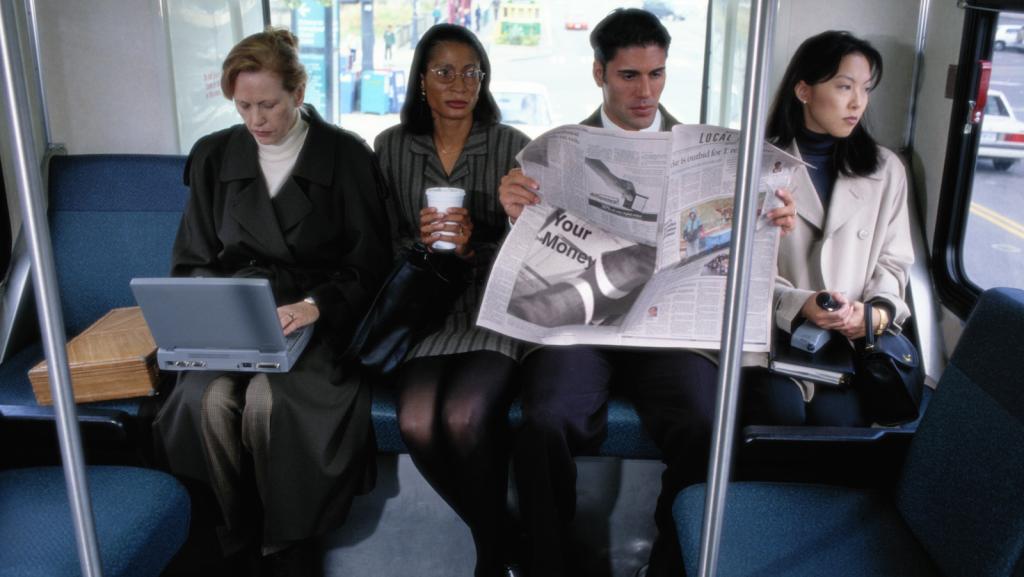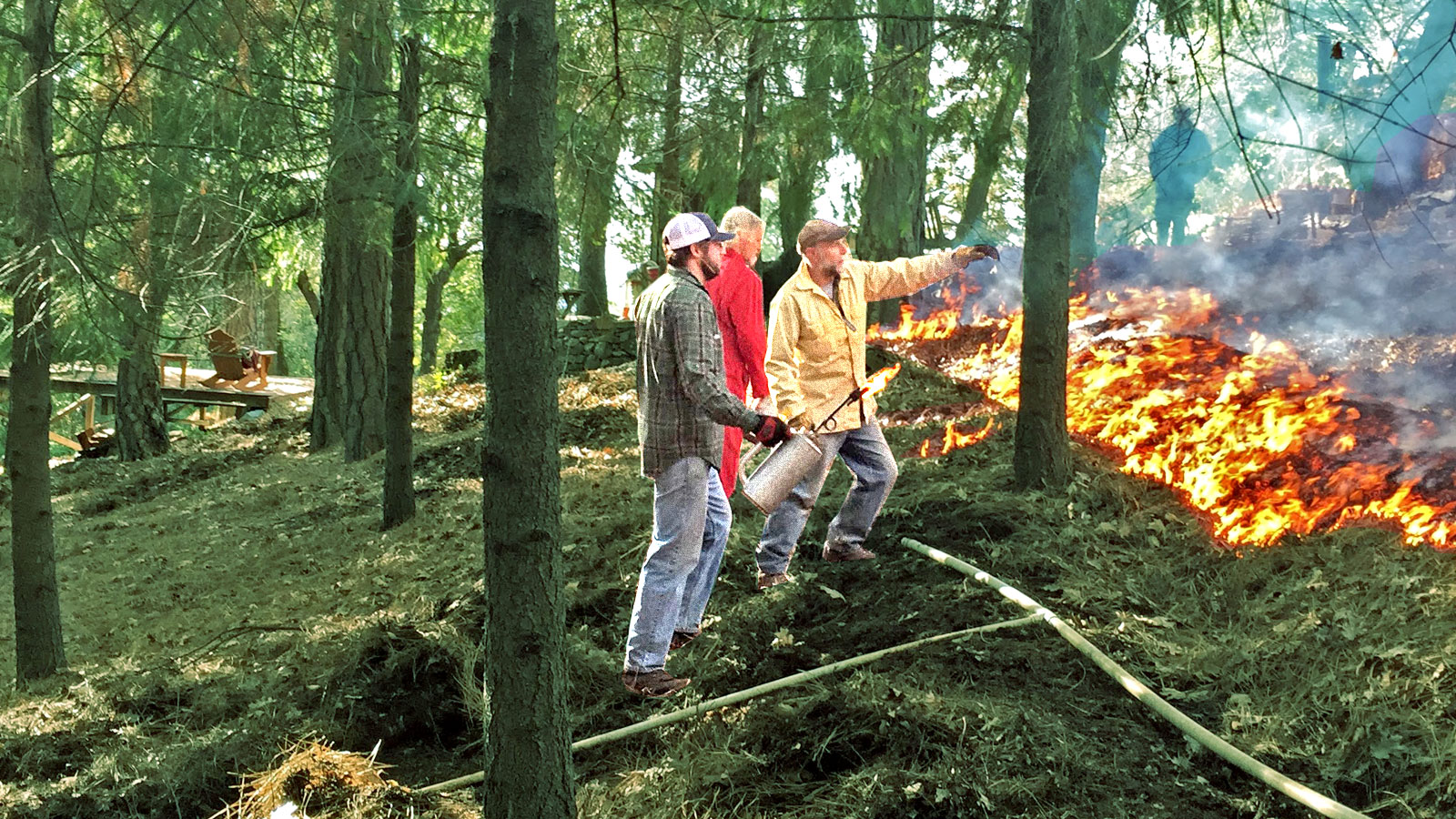On a crisp winter morning, while my daughters lingered over pancakes with their grandparents, I drove a couple of miles past houses nestled among incense cedars, Ponderosa pines, and Douglas firs. I couldn’t help imagining those trees roaring with flames, because I was going to watch the neighbors set a patch of land on fire.
I grew up here, in Nevada City, California, about halfway between Sacramento and Lake Tahoe in the northern foothills of the Sierra Nevada mountains. Like many of our neighbors, my family came for the forest, but with the forest comes forest fires. And in the last few years, it seems like all of the West has been on fire.
A quarter mile up a steep driveway, where the rising sun illuminated a panorama of wooded ridgelines, I met Dario Davidson, a retired forester wearing a grubby baseball hat and well-worn leather gloves. He was there to conduct a controlled burn, a way of clearing out the underbrush and leaves that provide tinder to wildfires. In one hand he picked up what looked like a low-key flamethrower, called a drip can, and with the other, he flicked a lighter until the mixture of gasoline and diesel at its wick flared. Then he tipped the can forward and dribbled out a line of flaming fuel onto the forest floor.
Immediately, a knee-high fence of fire rose behind him. Fire can mesmerize. It’s easy to get lost staring into the flames at a hearth; it’s even more fascinating to see them spread outdoors. I watched as the blaze transformed the top few inches of pine needles and oak leaves into a film of ash atop the older, decomposing duff. Sweet-smelling smoke gusted around us, and we backed away.
Perhaps I should have felt some respectful fear that this mini-forest fire might grow beyond our control. Sooner or later, a real wildfire will rage through here. Houses will burn, and the narrow roads will jam up. People I love, including my aging parents, could die. But I wasn’t even apprehensive: I’ve lived with the reality of wildfire for 40 years. So instead of fear, I felt a twinge of excitement as the flames rose.
Davidson gestured toward the blackened patch where the flames were guttering out, diminishing to smoke. He explained that the goal of this burn was to reduce the amount of fuel available to a future wildfire.
“This land has been pretty well-managed,” Davidson said. “There’s maybe 10 tons of fuel per acre here, versus 60 tons on nearby properties that haven’t been cleared out. That’s a big difference in terms of the BTUs [the sheer heat], and the number of embers that a big fire will produce.”
Even if you’re not surrounded by forest, that heat can be deadly. Nearby homes can burst into flames with high enough temperatures. And flying embers can seed dozens of new blazes. But trees and houses can survive a lower-intensity burn.
Davidson spread more fire, and the flames licked up tree trunks, charring the thick bark that evolved to insulate the living tissue inside from fire. For more than a century, we’ve managed to squelch fires, inadvertently creating the conditions for catastrophe. People have been doing prescribed burns for decades, but too few and too rarely to make much of a difference. After years of disastrous inaction, it was a relief to witness this little action — the fire’s warmth felt good, and the entire experience felt salutary. It was like getting out for a run after resolving to stop eating Christmas cookies and start exercising. This isn’t so bad, you think, why don’t we do this all the time?
The people of Nevada County are no strangers to fire. Wildfires stud my memories of growing up in Nevada County. In 1988, my parents packed valuables into our car as a blaze threatened to sweep through town. A few years later, when my brother and I were teenagers home alone one afternoon, we lugged a pump and hose out to our pond as embers fell around us and helicopters roared overhead. Winds kept that first fire out of the most densely populated areas, and people rebuilt what burned down. The second fire was a small blaze just over the hill from my father’s house, which firefighters managed to suppress within a few hours.
But things are getting worse. People here are feeling unusually nervous since wildfires consumed neighborhoods in Santa Rosa, Santa Barbara, Malibu, and Redding. Last year, the Camp Fire devoured the entire town Paradise just 50 miles north of here. When officials held a fire-safety meeting in Nevada County last month, residents filled the government building and packed the steps outside the meeting room.
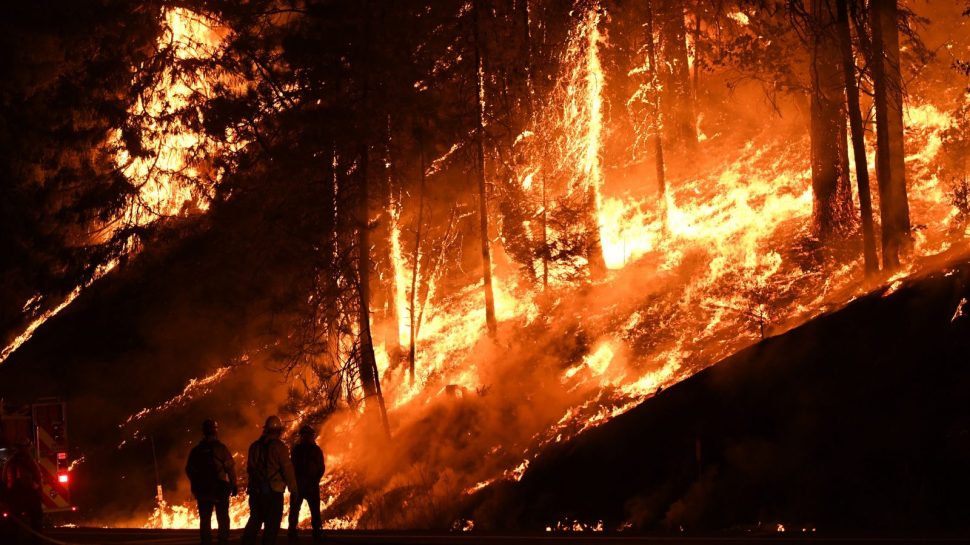
The Carr Fire spread near Redding, California, in July 2018. MARK RALSTON / AFP / Getty Images
“Business as usual” makes things a little worse every year. First, there are greenhouse gas emissions that make the summers hotter and drier in the West. Second, the forests produce tons of new fuel every year. For the 100-odd years that the government has been putting out fires in the western United States, the trees have been producing a steady rain of branches, leaves, and needles, creating a layer of duff that, in some places, is thick enough to keep water from trickling down to tree roots. Add that to the worst drought in history that parched the state from 2011 to 2014, throw in some voracious bark beetles, and you get 129 million dead trees in California, drying out and magnifying the risk of yet another devastating wildfire for the state.
Even if people don’t see the threat, insurance companies do. The increasing risk of fires is driving up the cost of insuring houses in wildfire-prone neighborhoods. Newspapers have run a bunch of stories about people around Nevada City who have found the cost unaffordable, and are moving out. The state insurance commissioner recently said that California is “slowly marching toward a world that’s uninsurable.” One company, Merced Property & Casualty Company, went belly up after the fire in Paradise burned down many of its customers’ houses.
Despite a flurry of stories in the media about people losing their insurance and leaving the area, Mark Sektnan, president of the Property Casualty Insurers Association of America, told me, “We’re not seeing a trend.” Insurance prices are increasing in some places, but California doesn’t allow insurers to jack up premiums based on recent disasters, and nearly everyone can find home insurance if they want it, he said. (Whether they can afford it is another question.)
“We started seeing all these stories about uninsurable properties and we thought we were seeing a crisis here,” Sektnan said. “But it turned out the same guy had talked to four different media outlets.”
The fire danger and high insurance prices will likely drive some Nevada City residents to relocate, but most seem to be staying put — at least for now. Big, slow trends, like climate change, hardly ever trigger radical actions. Instead, these shifts lead to gradual, piecemeal adaptation.
During my stay in Nevada City this winter, I asked several locals about the risks of staying put, they were sanguine about the wildfires menacing their homes, and insurance rates reflecting that risk. “When we moved here we realized the danger,” said Suzanne Ferroggiaro, who lives a few miles from my mother. “We’ve lived in different places and we’ve always had threats — tornado threats, hurricane threats, flood threats.”
It’s impossible to completely insulate yourself from natural disasters, and even the threat of wildfire is more widespread than you might expect. It’s not just a rural danger. The state fire agency, Cal Fire, says the towns in Nevada County are “very high fire hazard severity zones,” but so are swaths of Los Angeles, Oakland, and San Diego.
Most people aren’t retreating; instead, they are trying new techniques.
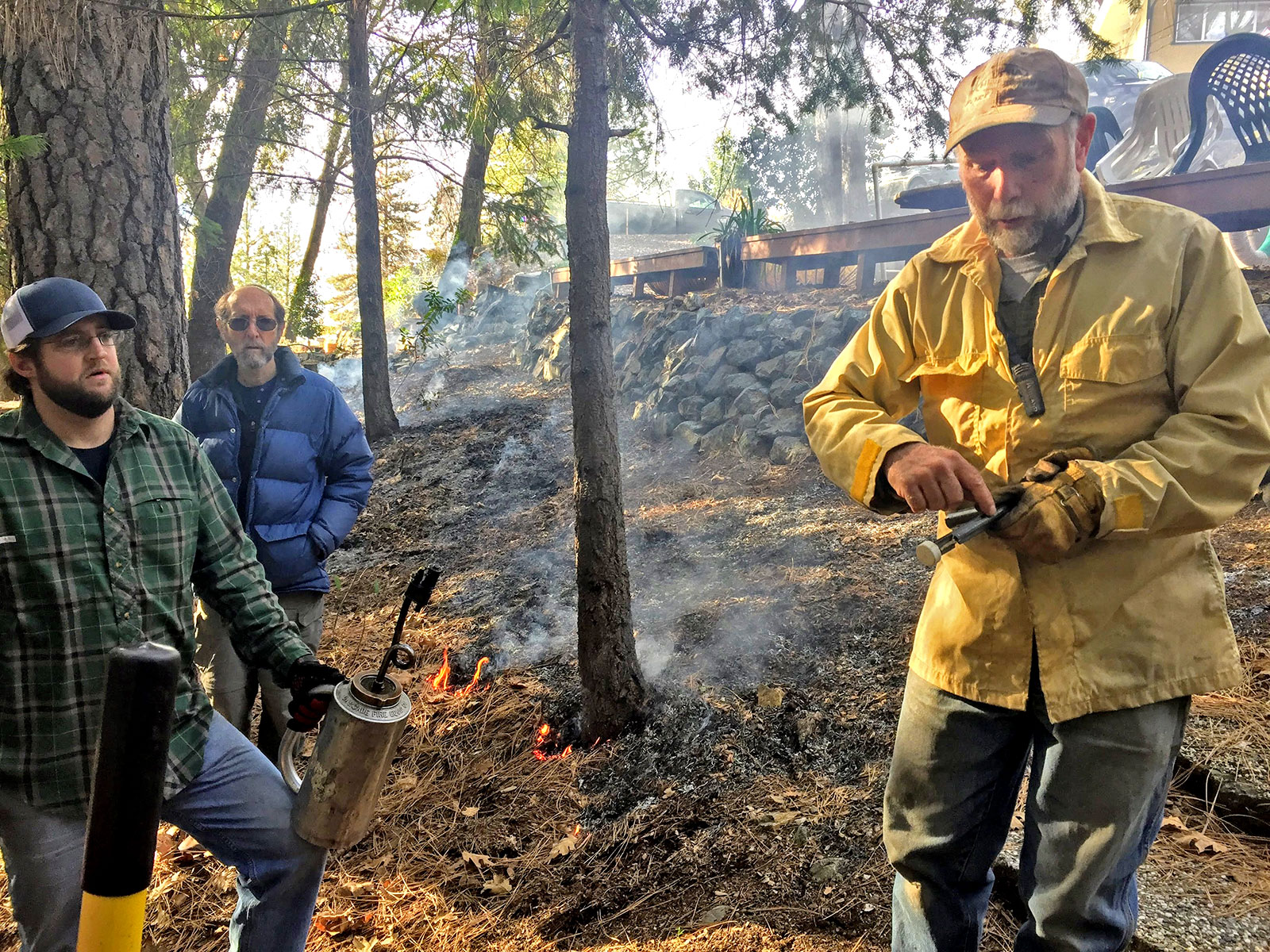
Grist / Nathanael Johnson
Back at the burn, Davidson was teaching the neighbors and a group of young foresters how to manage a controlled burn. Because fire moves uphill, they’d started near the top of the slope so that fire quickly moved to the upper perimeter — a line of bare dirt — where it ran out of fuel and burned out. Then the workers moved down a few feet and set a new line of fire so that the flames reached the previous burn scar before dying. With this technique, the fire always goes out on its own: You have to work to get the controlled burn to spread. “You just want it to be really slow and boring,” Davidson said.
Nonetheless, the workers had raked (“scratched” in forester jargon) out a perimeter line, clearing the needles (“down to mineral soil,” Davidson advised), which kept the fire a good 100 feet from Kathi Keville’s house. The controlled burn was something of a demonstration project for the Lower Colfax Firewise Community association, and neighbors had gathered to watch, learn, and help out.
This is a new phenomenon here in California’s fire country: not the use of controlled burns, but the willingness to participate in community organization to stem future fires. The numbers reflect this: There are 23 of these associations in Nevada County, 25 more have filed their papers to be officially recognized, and another 25 are organizing, according to the County fire council.
My parents have always cut back the manzanita and scotch broom to maintain Cal Fire’s recommended 100 feet of “defensible space” around their homes (though as they get older they hire others to do most of the work), but we never were part of a communal effort.
It was the same for Davidson. “I maintained my little five acres and thought I was safe,” he said. “Then I started looking at fire maps and I realized it was just a little postage stamp. I could do all the work I wanted and it would still burn if my neighbors did nothing.”
So in 2016, he began organizing meetings. From an initial mailing list of 26, the Lower Colfax Firewise Community association has grown to encompass 680 people, living on 421 parcels covering 2,900 acres.
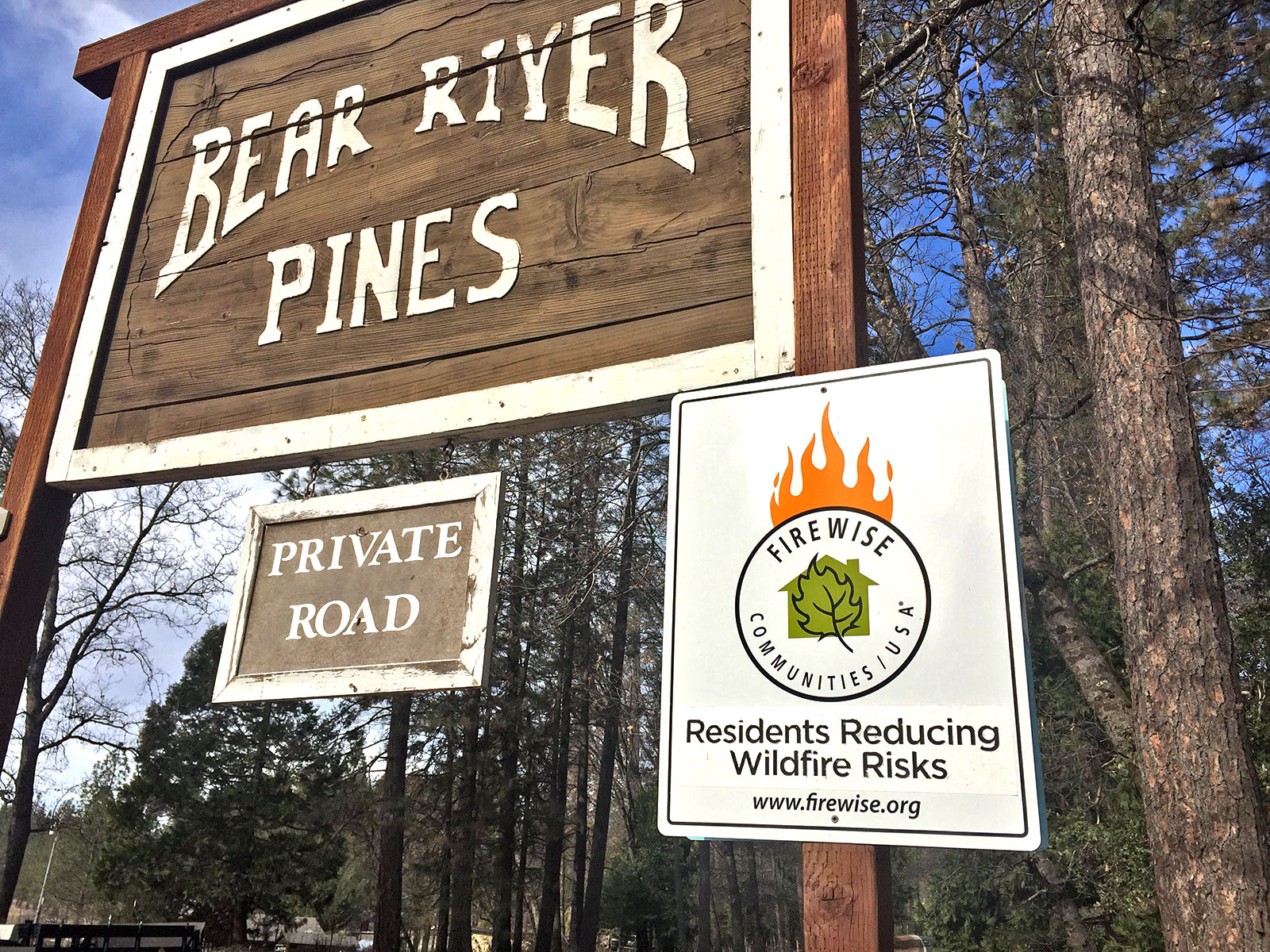
Firewise associations are popping up all over Nevada County. Grist / Nathanael Johnson
These community associations are a relatively recent development in California and a necessary one, said Scott McLean, spokesperson for Cal Fire. Neighbors help motivate each other, they educate each other, and they figure out who needs help. That last point is crucial during emergencies when fire agencies count on individuals to save one another.
“People need, not just a personal plan, but a community plan,” McLean said. “What about the little street they live on? Who is going to help out the elderly neighbors?”
When McLean’s former boss, Cal Fire Director Ken Pimlott, retired this year he gave a series of blunt exit interviews. “Folks can say what they want to say, but firefighters are living climate change. It’s staring them in the face every day,” he said. Individuals will have to organize themselves and local governments will need to improve their planning and regulations, Pimlott said.
So everything will have to change, but that has always been true. Californians have always had to adapt to their beautiful surroundings. “Fire is a way of life in California, and we have to learn how to live with it, we have to learn how to have more resilient communities,” he said.
As the climate continues to change we can expect to see a lot more adaptation like this. Where you might expect to see mass migration and big headline-grabbing actions, look for lots of local meetings, hyper-local associations springing up, and plenty of tinkering around the edges. Whether politicians in Congress ever figure out how to address the drivers of climate change, individuals no different from you and me will continue to hunt solutions that fit their communities.
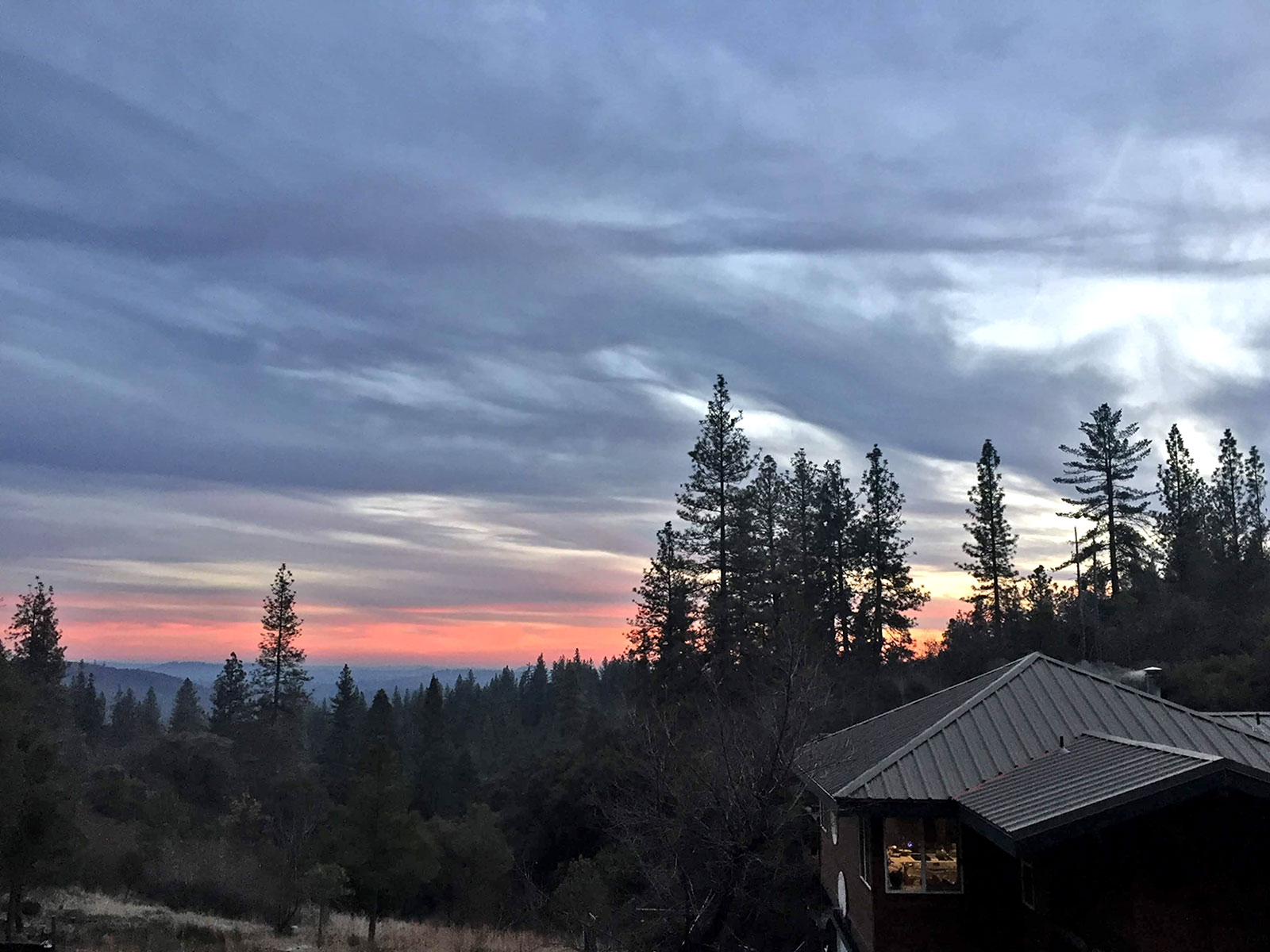
The view from my mom’s place in Nevada County. Grist / Nathanael Johnson
I left before the burn was finished (these things can take all day). At the end, the workers would tamp out embers and spray the area with water. They’d planned the burn between winter storms — a drenching rain with a chance of snow was due at the end of the week. Back at my mom’s house, I could see a scrim of smoke rising through the ponderosas from the direction of Keville’s property. But you probably wouldn’t notice the smoke if you weren’t looking for it. The sky was blue, and the air clear enough for me to see beyond the canyon where the Bear River runs, out past the next ridge that separates it from the American River watershed.
That tiny fire Davidson set might make this place a bit safer for my parents, and for my children when I drop them off for summer visits. There’s no way to completely avoid the environmental risks cued up by the missteps of the past. But if this sort of thing inspires more community efforts, and more individuals stepping up to take responsibility for the problems within their grasp, it might make us all a little safer.
